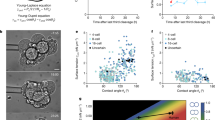Abstract
During embryonic development, orderly patterns of gene expression eventually assign each cell in the embryo its particular fate. For the anteroposterior axis of the Drosophila embryo, the first step in this process depends on a spatial gradient of the maternal morphogen Bicoid (Bcd). Positional information of this gradient is transmitted to downstream gap genes, each occupying a well defined spatial domain1,2,3,4. We determined the precision of the initial process by comparing expression domains in different embryos. Here we show that the Bcd gradient displays a high embryo-to-embryo variability, but that this noise in the positional information is strongly decreased (‘filtered’) at the level of hunchback (hb) gene expression. In contrast to the Bcd gradient, the hb expression pattern already includes the information about the scale of the embryo. We show that genes known to interact directly with Hb are not responsible for its spatial precision, but that the maternal gene staufen may be crucial.
This is a preview of subscription content, access via your institution
Access options
Subscribe to this journal
Receive 51 print issues and online access
$199.00 per year
only $3.90 per issue
Buy this article
- Purchase on Springer Link
- Instant access to full article PDF
Prices may be subject to local taxes which are calculated during checkout




Similar content being viewed by others
References
Wolpert, L. Positional information and the spatial pattern of cellular differentiation. J. Theor. Biol. 25, 1–47 (1969).
Driever, W. & Nusslein-Volhard, C. The bicoid protein determines position in the Drosophila embryo in a concentration-dependent manner. Cell 54, 95–104 (1988).
Driever, W. & Nusslein-Volhard, C. A gradient of bicoid protein in Drosophila embryos. Cell 54, 83–93 (1988).
Struhl, G., Struhl, K. & Macdonald, P. M. The gradient morphogen bicoid is a concentration-dependent transcriptional activator. Cell 57, 1259–1273 (1989).
Lacalli, T. C. & Harrison, L. G. From gradient to segments: models for pattern formation in early Drosophila. Semin. Dev. Biol. 2, 107–117 (1991).
Segel, I. H. Enzyme Kinetics (Wiley, New York, 1975).
Treisman, J. & Desplan, C. The products of the Drosophila gap genes hunchback and Kruppel bind to the hunchback promoters. Nature 341, 335–337 (1989).
Wimmer, E. A., Carleton, A., Harjes, P., Turner, T. & Desplan, C. Bicoid-independent formation of thoracic segments in Drosophila. Science 287, 2476–2479 (2000).
Struhl, G., Johnston, P. & Lawrence, P. A. Control of Drosophila body pattern by the hunchback morphogen gradient. Cell 69, 237–249 (1992).
Jackle, H., Tautz, D., Schuh, R., Seifert, E. & Lehmann, R. Cross regulatory interactions among the gap genes of Drosophila. Nature 324, 668–670 (1986).
Simpson-Brose, M., Treisman, J. & Desplan, C. Synergy between the hunchback and bicoid morphogens is required for anterior patterning in Drosophila. Cell 78, 855–865 (1994).
Hulskamp, M., Lukowitz, W., Beermann, A., Glaser, G. & Tautz, D. Differential regulation of target genes by different alleles of the segmentation gene hunchback in Drosophila. Genetics 138, 125–134 (1994).
St Johnston, D., Beuchle, D. & Nusslein-Volhard, C. Staufen, a gene required to localize maternal RNAs in the Drosophila egg. Cell 66, 51–63 (1991).
Ferrandon, D., Elphick, L., Nusslein-Volhard, C. & St Johnston, D. Staufen protein associates with the 3'UTR of bicoid mRNA to form particles that move in a microtubule-dependent manner. Cell 79, 1221–1232 (1994).
Roberts, D. B. (ed.) Drosophila, A Practical Approach (Oxford Univ. Press, Oxford, 1998).
Kossman, D., Small, S. & Reinitz, J. Rapid preparation of a panel of polyclonal antibodies to Drosophila segmentation proteins. Dev. Genes Evol. 208, 290–294 (1998).
Press, W. H., Teukolsky, S. A., Vettering, W. T. & Flannery, B. P. Numerical Recipes in C (Cambridge Univ. Press, Cambridge, 1992).
Merrill, P., Sweeton, D. & Wieschaus, E. Requirements for autosomal gene activity during precellular stages of Drosophila melanogaster. Development 104, 495–509 (1988).
Acknowledgements
Drosophila alleles were a gift from C. Desplan (FRT-hb,nosBN), E. Gavis (stauD3) and Nusslein–Volhard lab stock (staur9). This work has been partially supported by grants from the National Institutes of Health and the Howard Hughes Medical Institute. Discussions with C. Desplan, J. Grosshans, T. Lecuit, J. Reinitz and S. Small are here acknowledged.
Author information
Authors and Affiliations
Corresponding author
Ethics declarations
Competing interests
The authors declare no competing financial interests.
Rights and permissions
About this article
Cite this article
Houchmandzadeh, B., Wieschaus, E. & Leibler, S. Establishment of developmental precision and proportions in the early Drosophila embryo. Nature 415, 798–802 (2002). https://doi.org/10.1038/415798a
Received:
Accepted:
Issue Date:
DOI: https://doi.org/10.1038/415798a
This article is cited by
-
Early radial positional information in the cochlea is optimized by a precise linear BMP gradient and enhanced by SOX2
Scientific Reports (2023)
-
Size limits the sensitivity of kinetic schemes
Nature Communications (2023)
-
Thermal plasticity of wing size and wing spot size in Drosophila guttifera
Development Genes and Evolution (2023)
-
Precision of morphogen gradients in neural tube development
Nature Communications (2022)
-
Modulating the bicoid gradient in space and time
Hereditas (2021)
Comments
By submitting a comment you agree to abide by our Terms and Community Guidelines. If you find something abusive or that does not comply with our terms or guidelines please flag it as inappropriate.



